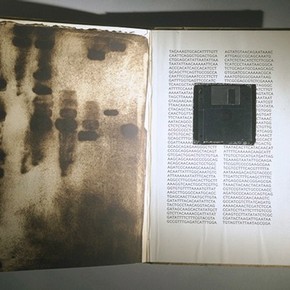Conservation Journal
April 1995 Issue 15
Editorial
A Leonardo da Vinci manuscript bought by Armand Hammer, the oil tycoon, became known as the 'Codex Hammer'. The manuscript was sold recently to Bill Gates, founder of Microsoft, for $30.8m. I will not dwell on the rich seam of economic and cultural symbolism of computer money buying out oil money, but I will hold it up as a commentary on the future of paper-based information (da Vinci's textblock) and non-traditional media (Microsoft's products).
As well as housing the Archive of Art and Design, the V&A is now responsible for its own archive. It is also acquiring large amounts of archives, including recently the other half of the Heal's Archive, and in future probably the Arts Council Archive. Thousands and thousands of bits of paper which must be preserved. And not just paper. Archives incorporate photographs, videos, audio-tapes and plastics. Nor is the Museum simply acquiring archives, it is also actively creating them. Funded by Jean-Paul Gautier, the Textiles Collection has started videoing catwalk shows. The Theatre Museum has instigated the National Video Archive of Stage

'Agrippa (A Book of the Dead)', artists' book, Dennis Ashbaugh and William Gibson, 1992. Photography by the V&A Photographic Studio. (click image for larger version)
Performance. Preservation solutions such as microforming and digitisation cast up their own preservation challenges. Who looks after the physical welfare of these media?
And there will doubtless be further developments in this field. A glance through 'Genre and physical characteristics: controlled terminology for the description of artists' books', produced by the National Art Library, indicates the use of the non-codex form and non-traditional materials, and suggests some of the future conservation challenges, for example:
'Auto-destructive books
use for destructive books, self-destructive books
narrower term edible books, decomposing books
related term 'kinetic books'
Kinetic books
use for books which rely for their effect upon constant movement eg powered by electricity, air etc....'
Copier books
use for xerox books, photocopier books'.
At a conference at the Tate Gallery last year entitled 'Modern Works - Modern Problems?' the home-made prints of David Hockney were discussed, consisting of colour photocopies which he then faxed to the Tate for exhibition. This is indication enough that the question of preserving faxes, photocopies, etc. is not a straightforward, traditional 'archives' issue centring on informational value, but encompasses issues of artifactual value as well.
Whilst it is all too easy to overemphasise the novel and the quirky and misrepresent the bulk of the collections, nevertheless, given that about half the Museum's collecting is of 20th century material, there is a range of materials, techniques, technologies and structures scarcely being addressed. The term 'Archives' is inadequate to cover all this collecting. The imperative to tackle these issues comes from several quarters. The larger question of archives touches on everyone in the Museum: for example the transience of thermal fax paper affects everyone's personal, as well as departmental and museum-wide, filing. The amount of paper in the Museum is already one of the biggest conservation problems and will probably be the fastest growing area in the future. The subject itself is developing in different directions, and is reflected in the Museum's actively collecting more multi-media archives and artifacts.
In this issue of the 'V&A Conservation Journal' the Parkes Collection of Japanese Papers is described. It is a good illustration of the ephemeral not being ephemeral. This collection of supposedly temporary objects made from paper in the late 19th century, such as drug bags and hair decorations, is now a unique record of exquisite artifacts unrivalled even in Japan.
There are currently the stirrings of a debate in the Department about where responsibility for the preservation of electronic media resides and whether indeed Conservation should be taking the lead. It is a multi-media, multi-material issue. As a conservation discipline, does it come under Photographs, Plastics, Books, Paper, Science or elsewhere? One of the benefits anticipated from the restructuring of the Department was more interdisciplinary work, and this would appear to be a prime topic.
Apart from 'Back of Burke' to describe the back of beyond, and 'Up the Track' to describe down the line, the most memorable phrase I heard in Australia was 'Whoever discovered water, it wasn't the fish'. I wonder if we have been overlooking a large and growing area in need of preservation in the Museum as we swim about in our daily work.
April 1995 Issue 15
- Editorial
- The Parkes collection of Japanese paper
- Restoration - is it acceptable?: review of the conference held at the British Museum 24-25 November, 1994
- To play or not to play: the ethics of musical instrument conservation
- The conservation and rehousing of a collection of photographs and photomechanical prints
- Book review: locked in the laboratory
- Conservation course abstracts: update